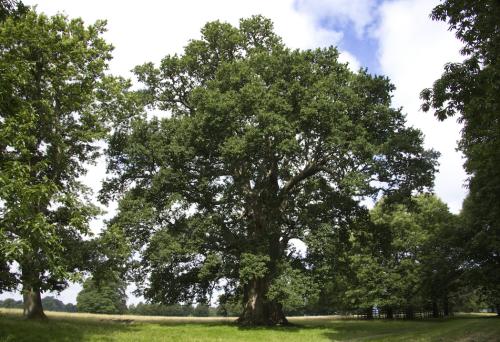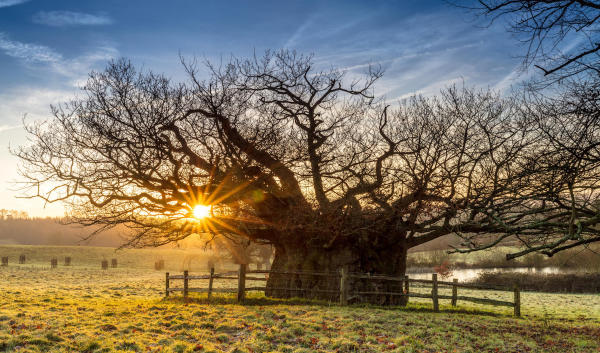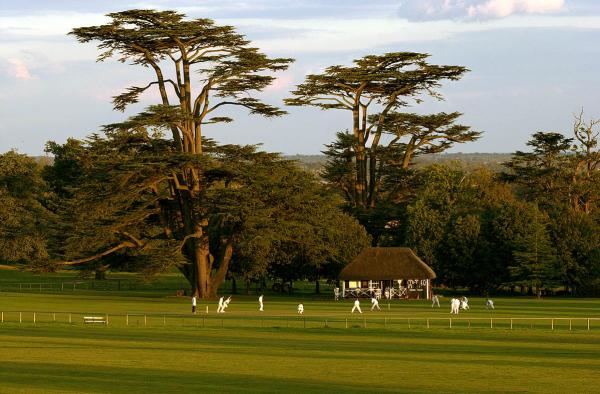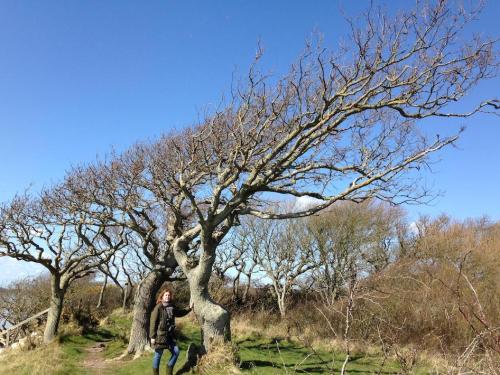The South Downs National Park has more woodland than any other National Park in England and Wales. In fact, 23% of the park is covered by trees, half of which have been here for over 400 years.
Explore the very best of our neck of the woods(!) on our self-guided tree trail, starting in our historic market town of Petworth and ending on the shores of our outstandingly beautiful Chichester Harbour.
Select one tree from the trail that you’d like to visit, or follow the tree trail in full over two or three days. The choice is yours.
We’ve included recommendations for walks and things to do near each tree, so you can make the most of your time. If you’d like to find overnight accommodation in each area, click here
The Norman Oak, Petworth Park
Back to Top of List
Petworth Park is home to some of the oldest and largest trees in the country. Just like the masterpieces that adorn the walls of Petworth House, the twisted and warped bark of these magnificent ancient trees make natural works of art to admire.
But one tree really stands out from them all.
Back in 1150, the Manor of Petworth was gifted by the widow of Henry I to the Percy family, who were powerful landowners in Northern England. The Norman Oak has witnessed all the landscape changes since then and has survived them all.
With hollies now growing from decomposing wood in its cavities, the Norman Oak makes quite the impression.
See it for yourself: See Petworth’s Norman Oak as well as its other impressive and ancient trees on the 4-mile circular Ancient Tree Walk detailed by the National Trust. Explore the beeches, limes and oaks that dominate the parks skyline, and spot some of the 700 fallow deer that call Petworth Park home.
Getting here: Petworth is on the route of Stagecoach route 1 bus which runs between Worthing and Midhurst (imetable available here) and the Book a Bus 99/99 Flex which can be accessed via the Ride Pingo app or by calling 01243 858854 (operating hours 6.30am-7.30pm).
While you’re here: Step inside Petworth House to admire some of the finest art collections in the care of the National Trust, continue to admire famous works of art at Petworth’s Newlands House Gallery, or check out Petworth’s world-famous antiques scene at Petworth Antiques Market. There are lots of great places to try for lunch or a coffee in this pretty market town.
The Queen Elizabeth Oak, Cowdray Estate (Midhurst)
Back to Top of List
Between 800 and 1,000 years old, the Queen Elizabeth I Oak can be found in one of the 16,000 acres that make up Midhurst’s prestigious Cowdray Estate.
Not only is the Queen Elizabeth I Oak one of the largest trees in Britain, but it’s rumoured to have met its namesake, Queen Elizabeth I, in 1591. It’s believed she sheltered under the tree and was impressed by its girth, which at 41 feet (nowadays), is quite some size.
See if for yourself: The Queen Elizabeth I Oak can be admired on a leisurely one-mile walk around the Cowdray Estate’s Benbow Pond.
Park at the pond and head towards Stewards Pond, where you’ll find the tree close by. While you’re there, make sure you take a walk through the avenue of lime trees planted to commemorate the Diamond Jubilee of Queen Elizabeth II.
Getting here: Midhurst is on the Stagecoach route 60 bus route, running between Midhurst and Chichester, Stagecoach 70 and 71 from Guildford, route 1 from Petworth and Stagecoach 90/91 from Petersfield.
While you’re here: There’s easily enough to keep you entertained all day at the Cowdray Estate from learning to play polo to a round of golf, let alone the rest of Midhurst. Indulge in seasonal delights at the award-winning Cowdray Farm Shop Café or learn more about Elizabeth I’s visit to Midhurst on a visit to Cowdray Ruins. If you want to gain a deeper connection with the local tree life, check out the forest bathing experience on offering with Midhurst’s Spread Eagle Hotel and Spa.
The Lebanon Cedar, Goodwood Estate
Back to Top of List
Although famous for its fine oaks and beech forest which surround the estate, some of the oldest and most notable trees at Goodwood are the Cedars of Lebanon.
The Cedars of Lebanon were planted in 1761 at the request of the third Duke of Richmond who introduced a range of species from across the world to the Goodwood Estate. While of the 1,000 that were originally planted, only a few remain today. However, these are now some of the finest examples of Lebanon Cedars in England.
Goodwood has an interesting history with trees, many of which have proved to be invaluable assets to the estate over the years. Once an estimated 33,000 beech trees were sold to cover death duties, while many Goodwood beeches played a part in the Second World War when they were shipped off to the front line for construction use.
After 1945 and again in the late 1950s, Goodwood’s forests were returned to their former glory when substantial replanting programmes were undertaken. Today, they’re carefully and sustainably managed to ensure they live on to delight visitors for years to come.
How to see it: Goodwood’s Cedar of Lebanon trees can be seen on a tour of Goodwood House.
Goodwood House is owned by the 11th Duke of Richmond and his family who live in the West Wing. The house is open for tours on set days throughout the year, and offers the chance to admire many private areas including the Ballroom, Egyptian dining room, tapestry drawing room and music room. Most importantly, you’ll get a perfect view of one of the famous Cedar of Lebanon trees ideally placed near a glistening pond. Tie up the house tour with afternoon tea on a Goodwood House Tea and Tour.
Getting here: Hop aboard the route 55 bus from Chichester city centre. Trains run into Chichester from London Victoria, Brighton, Southampton, Portsmouth and Littlehampton.
While you’re here: Essence maker Amy Murphy Watt has created a tree essence from the Goodwood cedar of Lebanon and you can book a 60 minute essence and healing with Amy at the Goodwood Health Club or have lunch at the award-winning sustainable Farmer, Butcher, Chef restaurant or Aerodrome Café, or The Fox Goes Free in Charlton, The Partridge Inn in Singleton or The Star & Garter in East Dean.
The Great Yew, Kingley Vale Nature Reserve (Chichester)
Back to Top of List
Not only is Kingley Vale home to one of the finest yew forests in Western Europe, but you’ll also find 11 different species of orchid and 39 species of butterfly here. It’s a pretty special place.
What’s more, its grove of ancient yews are among the oldest living things in Britain. Local folklore has it that the druids worshipped there before the Romans arrived, and that the archers of Agincourt used the agile wood make their bows.
While many of Europe’s yew forests were felled over the centuries, Kingley Vales remains one of the finest, with its Great Yew being shortlisted for the Woodland Trusts’ Tree of the Year in 2019. While it’s not the largest yew as far as its trunk is concerned, its great arching boughs form an impressive canopy to admire.
See it for yourself: Park in the Kingley Vale car park at Stoughton and take on the 6-mile circular trail around the nature reserve to see the Great Yew in all its finery.
Getting here: From Chichester the route 54 bus heading towards Petersfield stops at East Ashling, then from here it's approximately 20 minutes walk to the beginning of the Kingley Vale trail.
Arriving by bike? It's only a 20 minute cycle on from here to Chichester Marina to admire the amazing oak trees or head to the surrealist trees at West Dean, also around 20 minutes by bike.
While you’re here: It may come as a surprise to learn that Kingley Vale Nature Reserve is also one of the most important archaeological sites in Southern England, with 14 scheduled ancient monuments. Climb the slopes to take in some of the area’s most incredible views of the Solent and beyond.
Outside of the reserve, head to the Fox & Hounds for delicious global pub-grub in a 19th century inn, explore the eclectic mix of vintage furniture and Scandinavian inspired interiors set within a rural Sussex Barn at Design Vintage, or continue trekking but with an alpaca in tow at Dunreyth Alpacas - all within a five-minute drive of Kingley Vale Nature Reserve.
The Surrealist Trees, West Dean Gardens
Back to Top of List
Don’t stop reading when you realise these next trees aren’t real. They once were.
West Dean Gardens’ Surrealist Trees are fibreglass tree sculptures. Ivan Hicks (West Dean's Head Gardener in the 1970s) came up with the idea to immortalise trees that had been felled due to disease and old age. Sculptor, Ralph Burton was commissioned to encapsulate two standing timbers in fibreglass in 1972 and 1974. Whilst the timber has since rotted away, the fibreglass shells have been left behind, forming tree sculptures around the original trunks. A fitting surrealist legacy of the gardens’ founder Edward James, these trees can be spotted near the bridge in the Spring Garden, either side of the river. Edward James' grave can be found in St Roche’s Arboretum. The 49-acre arboretum is a must-see for tree lovers, with an abundant display of rhododendrons and azaleas in late spring.
How to see it: Admire the Surrealist Trees, St Roche’s Arboretum and much more on a visit to West Dean Gardens. Follow a 2.5 mile circuit walk to see a fine collection of specimen trees, shrubs and outstanding views of the Sussex Downs, or explore the gardens at your leisure.
Getting here: Stagecoach route 60 stops at West Dean Gardens, making this super easy to get to by public transport.
Arriving by bike? West Dean sits along the Centurion Way cycle route, offering you the chance to double up your tree stops with a visit to the majestic Cedars of Lebanon at Goodwood, under 30 minutes cycling, with most on this flat cycleway.
Whilst you’re here: While inside West Dean Gardens, ensure you pay a visit to West Dean Gardens Restaurant overlooking the beautiful Lavant valley and West Dean Park. Less than a five-minute drive from the gardens, you’ll find the Weald & Downland Living Museum.
The Stunted Oaks, Chichester Harbour
Back to Top of List
If you’re looking for photo opportunities, then our tree trail ends on a high.
Head on down to Chidham’s peninsula, in Chichester Harbour, to find majestic, gnarled oak trees.
Chichester Harbour is a designated Area of Outstanding Natural Beauty (AONB) and is an SSSI (Site of Special Scientific Interest). Whilst its sheltered waters provide a haven for wildlife, these surreal trees offer an insight into its unique habitat.
With their growth stunted by salt, these incredible old wind-blown oaks lean out towards the sea, making for an eerie but matchless photo.
How to see it: Follow the five-mile Chidham Peninsula Coastal Circular, beginning and ending in Chidham, to see the mesmerising stunted oaks. Along the route, you’ll get incredible views of the coast. You’ll also journey all the way to the southernmost point of the Peninsula, Cobnor Point.
Make the most of the views of the stunted oaks from the pebbly shores but be aware that part of this trail can only be accessed at low tide.
Getting here: Chichester Harbour is a perfect place to explore by bike, with a circular trail exploring the entire shoreline, even using the inexpensive Itchenor Ferry which happily lets bikes hop aboard too.
While you’re here: Pop into Old House at Home for lunch. Or, if you want to explore all Chichester Harbour has to offer, join a trip on a solar-powered boat with Solar Heritage, or take a seal or birdwatching trip with Chichester Harbour Conservancy.
Other great tree walks in Sussex
Back to Top of ListOur tree trail is just the tip of the iceberg when it comes to great trees in Sussex.
If you’re searching for other great days out that involve admiring astounding trees, check out some of our other suggestions below:
Halnaker Tree Tunnel
Walk through a tunnel of trees leading to one of Sussex’s most photographed windmills; Halnaker Windmill. The lane through the trees follows an ancient track along the Chichester to London Roman Road. With a sunken road and trees forming an arch overhead, you’ll get a real sense of stepping back in time as you travel through the Halnaker Tree Tunnel.
Giant Redwoods, Woolbeding Gardens
Admire the Coastal Giant Redwoods measuring over 33 metres tall at Midhurst’s Woolbeding Gardens. Dominating the 26-acres of horticultural haven you find surrounding them, you’ll find the redwoods dwarfing colourful plants, meadows, summerhouses, a contemporary glasshouse and even a river-god grotto.
Stopham Tree, Stopham Vineyard
The beautiful Stopham Vineyard has a stunning aspect, overlooking the flood plane of the River Rother. Rising up in the middle of the vineyard is a huge Corsican pine, perfect for finding a shady spot on a hot summer day. It is thought to be over 250 years old but who planted it remains mystery. Book a tour and wine tasting (£25) at this friendly, rustic vineyard between April and October (Saturdays at 11am or 2pm), you can add a 2-course lunch at the nearby riverside pub, The White Hart into the package (£50).
Famous Beeches, Chanctonbury Ring
Visit one of the most prominent landmarks in the South Downs National Park; Chanctonbury Ring. Best known for its famous clump of beech trees which were planted in 1760 by Charles Goring, this Iron Age Hill Fort offers the perfect picture opportunity. At the top you’ll find a selection of original trees (which survived the 1987 hurricane!) in addition to a selection of newer ones which where planted since.
If you’ve been inspired to get out and enjoy more of our wonderful Sussex woodland, find other great things to do, including great walks in Sussex, here.
Book a Bus Rural Bus Service
If you are struggling to find suitable public transport for your needs, we would recommend checking out Book a Bus, a convenient online platform that allows you to easily reserve and secure bus transportation tailored to your specific requirements. This service can be booked on the day or up to 24 hours in advance, providing flexibility to your journey planning.
Booking Options:
Online: Use the Ride Pingo app, which is the easiest way to book a bus. The app shows you where the service is, where it will pick you up, and when it will arrive. You can book up to five seats per trip, subject to availability. Phone: 01243 858854 (operating hours 6:30 am - 7:30 pm). Select option 1 for 99 Flex and option 2 for all other Book-a-Bus services. More information.
